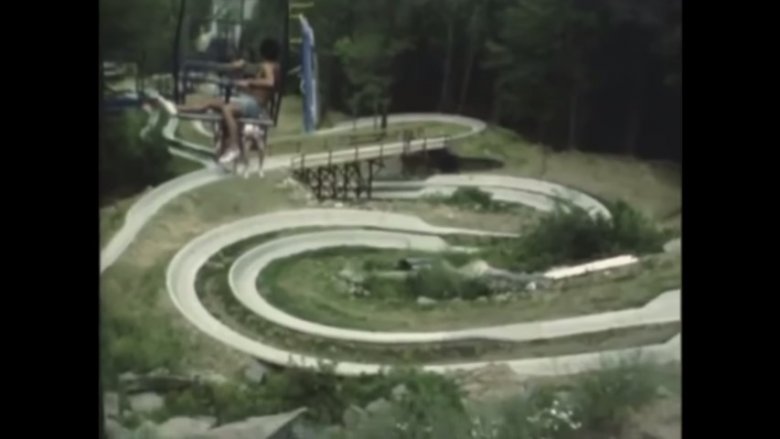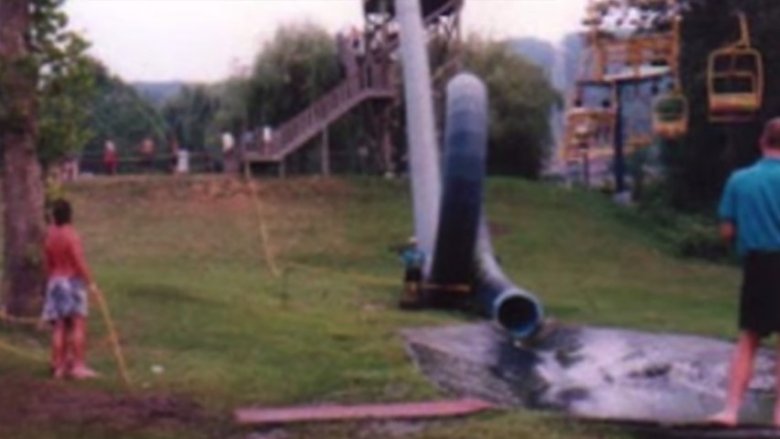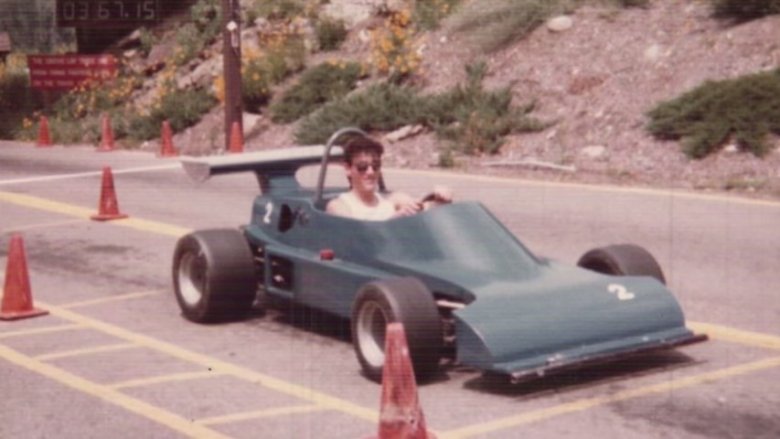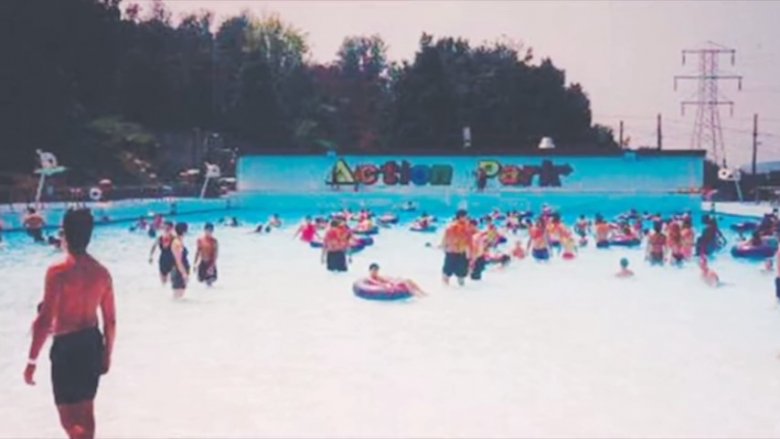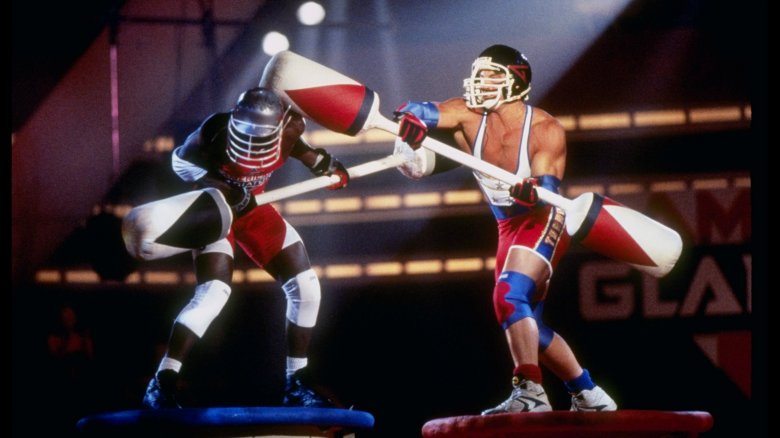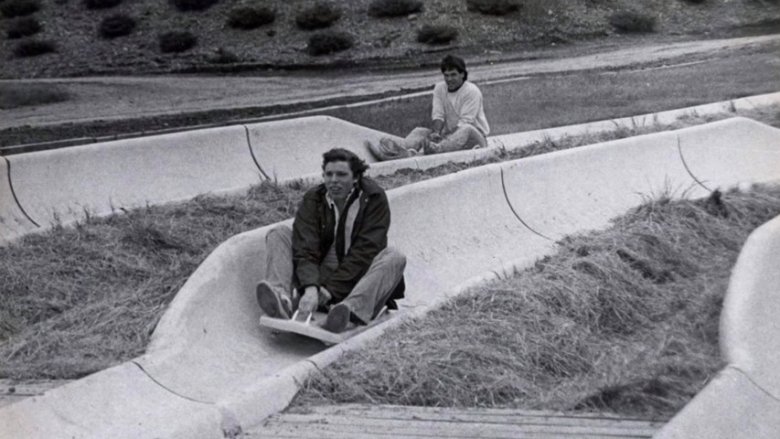The Untold Truth Of Action Park, The World's Most Dangerous Water Park
It was officially called Action Park, but those who went there — and experienced the bone-breaking, skin-ripping rides firsthand — tended to call it other things. Traction Park and Class Action Park were two of the most popular nicknames, and sometimes, things are funny because they're true and mankind has a sick sense of humor.
Action Park was the brainchild of Eugene Mulvihill, a New Jersey developer who was looking for a way to keep his Vernon Valley ski resort popular in the off-season. New York Magazine says the first ride was the Alpine Slide, and it sort of set the tone for the rest of the park. The slides opened on Labor Day of 1976, and more attractions followed in 1978.
But, let's be honest here. How bad was it really? Let's start with the thoughts of Evan Schuman, an investigative reporter for the New Jersey Herald. He wrote, "Once you've read the autopsies of the people who have gone on the rides, you tend to want to avoid it."
The horror of the Alpine Slide
Some ideas are brilliant even in hindsight. The Alpine Slide isn't brilliant any way you look at it, but if you want to say something good about it, you could go with "ambitious." Dress it up any way you like, but it was basically a 2,700-foot-long concrete and fiberglass track (via New York Magazine) down a mountainside so steep you needed a ski lift to get to the top. The daring (or dumb) would hop on a little cart with tiny wheels and some skids, then go barreling down the mountainside with only a little joystick-style control to combat the unforgiving forces that are friction and gravity.
Spoiler alert: Gravity and friction always win. Action Park's first death came on the Alpine Slide in 1980, when an employee's cart jumped the track. (There was nothing actually holding you on.) Newsweek says between 1984 and 1985 there were 26 head injuries and 14 broken bones just on the slide, but the most common injuries involved having skin torn from your body. Fun times! They also say it was such a danger that graphic pictures were posted at the base of the ride to warn park-goers about what they were in for. Ahh, the good old days.
The ride too dangerous to keep open
You'd think nothing would be too extreme for the sort of park manager who thinks posting bloody warning photos is a better idea than investing in actual safety equipment, but there was one ride deemed too dangerous to keep open past the first month. Anyone with even the most basic grasp of physics can see why Cannonball Loop was a bad idea, and according to Weird NJ, the Advisory Board on Carnival Amusement Ride Safety stepped in and shut it down.
Not entirely surprising. Cannonball Loop was technically a waterslide, one at a 45-degree angle that had about a 20-foot drop. At the bottom, daredevils (read: idiots) hit a full loop-the-loop, and occasionally, they actually made it all the way around. So many people didn't make the loop that they added an escape hatch to both drag people out and clear the sand, gravel, and grit that collected inside. Those who did make it around were spit out not into a pool, but on a sort of vaguely wet mat. io9 collected some eyewitness testimonies, including one from a park-goer who described it this way: "They made a godawful racket in there, with all the bumping around and the screaming, but they always made it out alive, though no one was foolish enough to ride it a second time."
The Tarzan Swing
Watch any 1980s coming-of-age movie, and there's almost always a scene where our group of teenage heroes heads off to the old swimming hole for at least one summer afternoon. There's always a rope or a tire swing there, and someone swinging out over the water for free-fall fun. That was the general principle of the Tarzan Swing, and how on earth could this one be turned into a potential death trap? Kids have been making their own versions of this for years, and kids are dumb! Surely, adults can do better?
Sometimes, adults are dumb, too. Weird NJ says not only was it the source of countless scrapes and other minor injuries, but the water was so frigid people would hit it and immediately forget how to swim. It can't be that cold, you're thinking. It was. One man died there in 1984, when he hit water so cold it allegedly triggered shock and a heart attack.
Super SUPER Go Karts and Speedboats
Remember the days when you felt the need for speed, and Go Karts were an exciting alternative to your boring old bicycle? Action Park Super Go Karts tended to be on the side of super, super exciting, mostly because they were super easy to hack. Technically, they were capped at speeds of 20 mph, which is exciting but rational. But Action Park employees found out pretty quickly that jamming a tennis ball in the engine kicked their max speed up to around 50 mph. This led to some games of high-speed bumper Go Karts (via AV Club).
What's better than Go Karts? Speedboats! Action Park had those, too, and like the rest of the park, this crazy ride came with an insane twist. Super Speedboats could clip along at up to 40 mph, and honestly, how could you think people weren't going to use these as bumper speedboats? It's also worth noting they weren't set up in a clean, chlorinated pool — they were set up in a swamp. Lifeguards were stationed on an island in the middle of the swamp, and Weird NJ says they shared the area with a healthy population of water snakes. There was at least one incident where an enthusiastic game of bumper speedboats led to the boats flipping and trapping drivers underwater. It's a safe bet that Action Park lifeguards did not get paid enough.
The Grave Pool
It wasn't officially called The Grave Pool, of course, but it should have been. Action Park's Tidal Wave Pool was the first in the U.S., says History, and it's amazing there were ever any more because there were a whole bunch of problems with this one.
The pool was 8 feet at the deepest point, 250 feet long, and 100 feet wide (via Weird NJ). Four massive fans generated waves more than 3 feet high, and those fans were turned on for 20 minutes at a time with 10-minute breaks. Up to 1,000 people were allowed in the pool at any given time, and most of those people were city folk who weren't familiar with the mechanics of even basic swimming. See where this is going?
It gets worse, and here's where science comes in again. It's easier to float in the ocean because of the salt content of the water, but Action Park's pool was freshwater. Pulling drowning people out of the pool wasn't just regular, it was constant. There were always 12 lifeguards on duty, and each one averaged around 30 saves a day. Their record wasn't perfect either. Three people drowned and died in the pool.
There were 'only' six deaths
Referring to six deaths as "only" six deaths might be acceptable if you're talking about something like a natural disaster or a war, but not an amusement park. Many urban legends have sprung up around Action Park — along with stories of more deaths that went unreported or were covered up — but let's count the official ones (via Mental Floss).
The first was on the Alpine Slide in 1980, when a 19-year-old employee hit his head on a rock after his cart jumped the track. The second and third came in 1982. First was the drowning death of a 15-year-old boy in the wave pool, and it was only a week later that a 27-year-old man was electrocuted on The Kayak Experience. (Newsweek says there was a massive investigation after he was tipped out of his boat and touched an exposed wire. The New Jersey Labor Department found Action Park wasn't responsible, but the ride never reopened.) Number four was the 1984 death on the Tarzan Swing, and five and six were 1984 and 1987 drowning deaths in the wave pool. Sometimes, the truth is horrible enough without any embellishment.
Average emergency room visits
Six deaths is a high enough number, but when you start talking about injuries and emergency room visits, you get way beyond being able to count on your fingers and toes. Exact tallies are understandably scarce, but there are some staggering numbers you can pluck from various sources.
New York Magazine says the official injury total for 1985 was 110, a number that includes 45 head injuries and 10 broken bones. (Remember, those are just the ones severe enough to be reported.) For the first years the park was open, those numbers weren't uncommon. Untapped Cities says local emergency rooms estimated between 5 and 10 park guests a day ended their fun adventure by sitting in the hospital, and that ambulances were making so many trips to Action Park that the park paid to put a few more on call. That's ... a charming gesture of goodwill?
Bizarrely, Action Park was even able to spin this insane injury rate as a good thing. They took a weird official stance, and said they were a special sort of park because of the agency they gave their guests. Visitors were responsible for making their visit as extreme — or as bloody — as they wanted, and who was Action Park to get in the way of all their fun?
You could beat the tar out of someone
Everyone can agree the 1980s were a different time. No one wore bike helmets, curfews were "sometime around dark", and parents were fine with the fact they didn't have GPS trackers constantly monitoring their kids. You can almost give Action Park a bit of a pass for that, but you'd also be tempted to think they'd learned their lessons by the time the 1990s rolled around. You would be wrong.
In 1992, The Daily Gazette reported on an awesome new attraction where the goal was to literally beat the tar out of someone else, among other things. The inspiration came from the then-hit show American Gladiators, and involved an obstacle course (complete with cargo net climb and wall climb), and it ended with heading up onto a 3-foot-high podium to joust with one of the Action Park gladiators. Win, and you were promoted to the 6-foot-high podium to face off against a gladiator named Titan. And yes, they were legit opponents, all professional bodybuilders who went through a serious try-out before being hired. The whole thing was staged in the style of a medieval joust at a Ren Faire, with a commentator making fun of challengers over a loudspeaker, often in front of a crowd of hundreds. Sounds like a great time.
It was an underage free-for-all
On May 21, 1986, The New Jersey Herald ran Evan Schuman's expose on Action Park employees. It was, of course, an expose that would have come as no real surprise to anyone who had been there and who worked there, but it still preserved this particular slice of Action Park history for posterity.
Even though operation manager Adam Ringler went on record to deny there were any underage people working at the park, pretty much everyone else said, "There are lots of underage people working at the park." Schuman tracked down about a dozen 14- and 15-year-olds who said they were totally operating rides and giving out medical attention whenever it was needed. Staff looked particularly youthful at the end of the summer, when most of the older kids headed back to high school or off to college.
That's a problem, and History says there was another big problem: underage drinking. Visitors and employees alike were allowed to drink pretty freely, and an overwhelming number of injuries happened to people who'd had a little too much liquid courage. Surprised? Didn't think so.
There were lots of lawsuits but few fines
The New Jersey Herald's Evan Schuman found there were just as many lawsuits as you might expect, and he also found six-figure settlements were basically a part of the park's overhead. Between April 1983 and April 1985, there were around 200 lawsuits filed against Action Park. There were also the lawsuits filed over the deaths in the park. (Only three had happened when Schuman was writing.) At the time, the largest award was for $118,000, to a Brooklyn man injured on the Blue Water Slide.
That's nuts, and even nuttier is the official statement from park operations manager Adam Ringler: "Action Park attorneys do take a hard-line stance with regard to settlements, as most suits are of a frivolous nature."
You'd think the state government would be all over a place like this, but more shocking than the number of lawsuits the park received is the number of fines. Schuman reported that as of 1986, Action Park had been fined once: They got a $300 fine in 1979 for operating a ride without a permit.
Who would provide insurance for that?
If you've owned something worth more than one paycheck, you probably know how insane insurance premiums can get, especially if your record is less than perfect. That brings up another bizarre and fascinating question: Who the heck would insure this place?
The New Jersey Herald reported the park was having difficulties securing insurance prior to the 1986 season, and while it wasn't a new problem, owner Eugene Mulvihill was going to have to find a new solution. In November 1984, he had pleaded guilty to charges that essentially amounted to the creation of a fake insurance company located in the Cayman Islands. The company existed on paper only and created just to give the appearance of legitimately having insurance. Settlements were then paid out not by any insurance company, but by the corporation itself.
New York Magazine says that should have been the end of Action Park. Mulvihill was handed three years of probation, $300,000 in fines, and an order to sell the property. Then he just didn't, and no one followed up. By 1986 he was expanding his holdings by buying from the state a mountain that he had been renting for part of the park.
It only technically closed
Action Park is the stuff of days gone by, when safety was just a word amateurs used. Right? Not quite. New York Magazine says it officially declared bankruptcy in 1995, and was bought by another company and then reopened as Mountain Creek Waterpark in 1998. In 2010, ownership went back to the Mulvihill family, and in 2014 — two years after the death of the infamous Eugene Mulvihill — son Andy restored the name amid promises to make it safer. Did it work? Well...
Cannonball Falls was shut down in August 2015 after a series of injuries that cemented the ride's status as record-holder for ride-related injuries in the state (via NJ.com). In 2014, there were 25 accidents reported at Action Park. That may not sound like much — at least, not compared to the old Action Park — but NJ.com notes it was still more than any other park in the state. They were back making headlines at the New Jersey Herald again in 2018, too, when a portion of the water park was overcome with chlorine fumes and 15 people were taken to the hospital for treatment.
The Health Department ruled it an "anomaly."

